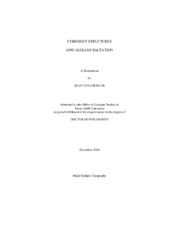| dc.description.abstract | Aeolian sand transport models, widely employed by coastal scientists and managers,
assume temporal and spatial homogeneity within the saltation field. This research questions that
assumption by demonstrating that the saltation field is event-driven, therefore indicating that the
saltation field is not temporally steady. The findings from this research may explain a portion of
the conclusions from previous studies that indicated inequalities between model-estimated and
field-measured aeolian sand transport.
The relationship between unsteadiness in a turbulent wind field and pulses in a sand
transport field was investigated on a beach near Shoalhaven Heads, New South Wales, Australia.
Microphone-based saltation sensors, “miniphones,” and thermal anemometers (both instruments
constructed exclusively for this field experiment) were co-located (0.02 m separation on center)
and deployed between 0.01 and 0.0225 m above the bed, and sampled at 6000 Hz. Average grain
size at the field site was 0.30 mm. Five runs totaling 2050 seconds of wind and saltation data
were analyzed.
The continuous wavelet transform, using the Morlet wavelet base, was the principle
method for analyzing the wind and saltation records. The cross continuous wavelet transform was
used to analyze the wind and saltation time series concurrently. Wind, saltation, and cross events
were discerned by selecting wavelet power coefficients between wavelet scales of 0.4 and 3.0
seconds and with coefficients exceeding the 95% confidence interval.
Average event spacing was 6.10, 6.50, and 6.73 seconds for the wind, saltation, and cross
events, respectively. The average event spacing measured in this research was compared to the
empirical-based model presented by Rao, Narashimha, and Narayanan (1971). The
correspondence between the model and this research strongly suggests that bursting-type coherent
structures were present. The durations of average wind, saltation, and cross events were 1.87,
2.10, and 1.73 seconds, respectively. Integral time scales, calculated using normalized auto correlation and power spectral density analysis, were approximately two seconds for the wind and
saltation systems. The temporal coincidence of the integral time scale estimations and the event
durations for the wind and saltation system strongly suggests that wind events are driving sand
transport events. | en |


